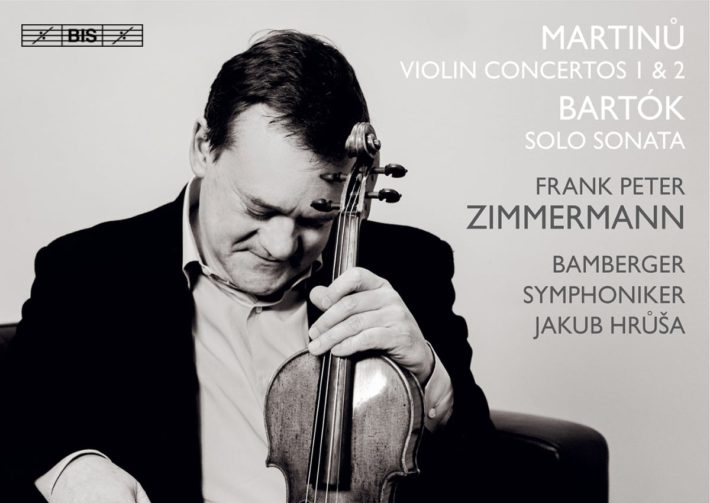Martinů’s symphonic music has slowly been gaining a foothold in recorded repertoire over the last thirty years. His orchestral music features luminous orchestration, elegant melodies and driving, syncopated rhythms, all firmly rooted in tonality. While his second violin concerto has been recorded a number of times, this latest release of the first violin concerto (considered lost until its rediscovery in the late sixties) is only its fourth recording.
This new recording opens with thrilling performance of the better-known second concerto. The orchestra’s restless, dissonant chords are answered by the soloist’s more lyrical music, which eventually ushers in a beguiling gentleness (1’31”) and sustained for the remainder of the movement. Zimmermann’s sound is warm, rich, and sophisticated, which suits this music perfectly. Hruša and the Bamberg players make the most of their accompaniment, revealing a wide variety of articulations and colors. Sample their impressive unanimity and energy building into the secondary theme (3’45”- 4’53”), as well as the sensitive dialoguing between Zimmermann, timpani, woodwind, and horns beginning at 5’40”. The cadenza (9’44”) is breathtaking, double and triple stops played with unerring accuracy and faultless intonation.
The second movement is played at an elastic and flowing tempo that instills an attractive lightness and buoyancy. Martinů’s love of a long, lyrical melody is readily apparent, and Zimmermann plays with a singing, clear tone across all registers. If you have never heard Martinů’s music, sample the passage at 5’20”, in which an ascending scale pattern begins to permeate the orchestration glittering and impressionistic. The soloist is then drawn into the same ascending figure, varied by a kaleidoscope of shifting colors until the music ends by floating up and away. The third movement quickly returns us to earth, syncopated, jazzy rhythms introducing the most overtly virtuosic solo writing. Soloist and orchestra establish a wildly jubilant mood that at 2’03” becomes more playful. In Zimmermann’s hands, this challenging, acrobatic music sound effortless, and the coda brings a burst of speed that leads into an exultant conclusion.
Related Classical Music Reviews
- Review: “Bohemian Tales” – Augustin Hadelich, Violin
- Review: Korngold – Violin Concerto, Sextet – Haveron, Wilson
- Review: “Belle Epoque” – Daniel Hope, Violin
Commissioned by American violinist Samuel Dushkin in 1932, Martinů’s first concerto took an exceptionally long time to complete, because of Dushkin’s insistence on being an active part of the compositional process. The previous year he had premiered Stravinsky’s concerto, and Stravinsky, who was not a string player, gratefully accepted and incorporated Dushkin’s many suggestions. Dushkin expected the same “cooperative” approach from Martinů (although Martinů had been a violinist in the Czech Philharmonic!). Dushkin repeatedly requested changes that would highlight his flashy and virtuosic style. By 1934 Dushkin was ready to premiere the work, but the political upheavals forced its cancelation. Eventually considered lost, the score was rediscovered at Northwestern University in Washington (USA) in 1968 and was finally premiered in Chicago in 1973.
The concerto is certainly more focused on technical display. After a short orchestral introduction, built on an angular syncopated melodic line suggestive of Stravinsky’s new-classic style, the soloist enters with incessantly busy writing, featuring arpeggios, syncopated runs and double, triple and quadruple stops. There is a wonderful moment where the busyness finally relaxes, allowing Martinů to write another of his elegant long-spun melodies (track 4, 5’10”). The second movement explores that lyricism more fully, while the final movement returns to the ornamented, bravura writing, with several short solo cadenzas and a particularly enthralling coda. By the end of the work one might feel we have worked through a catalogue of various technical hurdles, which Martinů somehow makes into convincing, organic, and fiercely life-affirming music. Zimmermann performs with an almost gleeful elan, while Hruša and his Bamberg orchestra are distinctive, perceptive accompanists.
Bartók’s solo Sonata is a generous filler. More angular and dissonant than the concertos, Zimmermann’s performance is intensely musical and involving, the many sudden changes in dynamics, articulation and register played with panache. His sound in the Sonata is powerful and fulsome without becoming aggressive. He does not shy away from dissonance, nor does he seek to magnify its harshness. I imagine some listeners might want a more robust, earthier sound.
BIS’s recording is typically excellent: the soundstage wide and deep, the bass response quite powerful. Zimmermann’s instrument is always clearly heard, even in the loudest passages, without ever sounding artificially spotlighted. With excellent program notes and stunning playing, this release is an easy recommendation.

Martinů – Violin Concertos No. 1 &2
Bartók – Solo Violin Sonata
Frank Peter Zimmermann – Violin
Bamberger Symphoniker
Jakub Hruša – Conductor
BIS, Hybrid SACD BIS-2457
Recommended Comparisons
Read more classical music reviews or visit The Classic Review Amazon store
Follow Us and Comment:
Get our periodic classical music newsletter with our recent reviews, news and beginners guides.
We respect your privacy.








